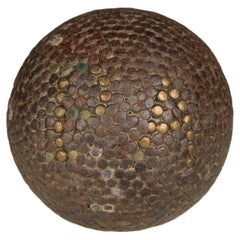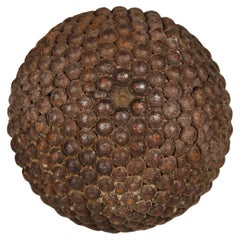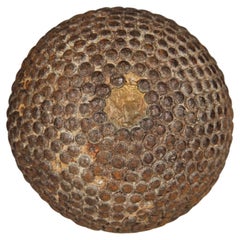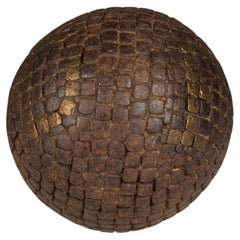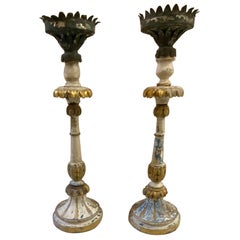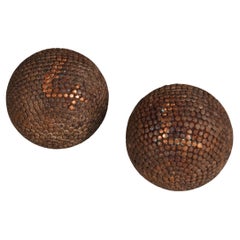Carved Antiquities
to
16
94
61
167
1
37
28
10
3
2
1
1
1
37
84
46
1
22
8
6
4
2
1
1
2
142
42
40
30
13
102
39
24
20
17
168
168
168
9
6
1
1
Technique: Carved
Antique Boule Ball "P A", Pétanque, 1880s, France, Craftsmanship
Located in Greven, DE
Beautiful, unique Boule ball, France, late 19th Century.
In the 19th century, the manufacture of boules balls underwent significant development in France as the game of boules, part...
Category
Late 19th Century French Late Victorian Antique Carved Antiquities
Materials
Metal
Antique Boule Ball "B", Pétanque, 1880s, France, Craftsmanship
Located in Greven, DE
Beautiful, unique Boule ball, France, late 19th Century.
In the 19th century, the manufacture of boules balls underwent significant development in France as the game of boules, part...
Category
Late 19th Century French Late Victorian Antique Carved Antiquities
Materials
Metal
Antique Boule Ball, Pétanque, 1880s, France, Craftsmanship
Located in Greven, DE
Beautiful, unique Boule ball, France, late 19th Century.
In the 19th century, the manufacture of boules balls underwent significant development in France as the game of boules, part...
Category
Late 19th Century French Late Victorian Antique Carved Antiquities
Materials
Metal
Antique Boule Ball "D F", Pétanque, 1880s, France, Craftsmanship
Located in Greven, DE
Beautiful, unique Boule ball, France, late 19th Century.
In the 19th century, the manufacture of boules balls underwent significant development in France as the game of boules, part...
Category
Late 19th Century French Late Victorian Antique Carved Antiquities
Materials
Metal, Brass
Carved Candle Stick
Located in Dallas, TX
18th century carved candle stick.
Category
Mid-18th Century Italian Rustic Antique Carved Antiquities
Materials
Paint, Wood
$1,540 Sale Price
30% Off
Pair Of Antique Boule Balls "4", Pétanque, 1880s, France, Craftsmanship
Located in Greven, DE
Beautiful, unique Boule ball pair, France, late 19th Century.
Diameter 9,4 cm.
In the 19th century, the manufacture of boules balls underwent significant development in France as th...
Category
Late 19th Century French Late Victorian Antique Carved Antiquities
Materials
Olive
Antique Boule Ball "62", Pétanque, 1880s, France, Craftsmanship
Located in Greven, DE
Beautiful, unique Boule ball, France, late 19th Century.
In the 19th century, the manufacture of boules balls underwent significant development in France as the game of boules, part...
Category
Late 19th Century French Late Victorian Antique Carved Antiquities
Materials
Metal
Russian Carved Coachman 18-Karat Gold Enamel Lapis Figure Manner of Fabergé
By Peter Carl Fabergé, Modern Fabergé
Located in San Diego, CA
Exquisite hand carved Russian hard stone "Coachman" sculpture figure dating from the early 1900s. In the manner of Fabergé. Made of solid lapis lazuli. Beard is made of gray obsidian...
Category
Early 20th Century Russian Carved Antiquities
Materials
Lapis Lazuli
$6,000 Sale Price
20% Off
Pair Of Antique Boule Balls "G", Pétanque, 1880s, France, Craftsmanship
Located in Greven, DE
Beautiful, unique Boule ball pair, France, late 19th Century.
In the 19th century, the manufacture of boules balls underwent significant development in France as the game of boules,...
Category
Late 19th Century French Late Victorian Antique Carved Antiquities
Materials
Olive
Antique Boule Ball With Star Decor And C, Pétanque, 1880s, France, Craftsmanship
Located in Greven, DE
Beautiful, unique Boule ball, France, late 19th Century.
In the 19th century, the manufacture of boules balls underwent significant development in France as the game of boules, part...
Category
Late 19th Century French Late Victorian Antique Carved Antiquities
Materials
Metal, Brass
Antique Boule Ball "7", Pétanque, 1880s, France, Craftsmanship
Located in Greven, DE
Beautiful, unique Boule ball, France, late 19th Century.
In the 19th century, the manufacture of boules balls underwent significant development in France as the game of boules, particularly the pétanque variant, gained in popularity. The manufacture of boules balls during this period was a manual process that required expertise, precision and love to detail.
In the late 19th and early 20th centuries, particularly in rural areas of France and other Mediterranean regions, olive wood was a commonly used source of material for making boules balls. This was not only due to the availability of the material, but also to the outstanding properties of olive wood, which was characterized by hardness, strength and a rich grain.
First, the olive wood was carefully selected and shaped into raw balls, which were then sanded to the desired size and shape. The nails were then hammered into the balls one by one, making sure that they were evenly distributed and firmly anchored. Finally, the spheres were polished and coated with a protective varnish to enhance their natural beauty and protect them from the elements.
The use of nails to decorate and reinforce olive wood boules was a traditional practice that not only gave the ball a rustic aesthetic, but also improved its durability and contributed to customization. Many balls were made according to the specific requirements and preferences of the players. Nails were driven at regular intervals around the ball, with each nail hole precisely placed so as not to affect the balance and weight distribution of the ball. These nails not only served as a decorative element, but also helped to strengthen the structure of the ball and make it more resistant to the hard knocks and wear and tear during play. Individual engravings or decorations were often applied to the balls to make them unique and identify the player.
Antique boules...
Category
Late 19th Century French Late Victorian Antique Carved Antiquities
Materials
Metal
Pair Of Antique Boule Balls, Pétanque, 1880s, France, Craftsmanship
Located in Greven, DE
Beautiful, unique Boule ball pair, France, late 19th Century.
Diameter 9,5 cm.
In the 19th century, the manufacture of boules balls underwent significant development in France as the game of boules, particularly the pétanque variant, gained in popularity. The manufacture of boules balls during this period was a manual process that required expertise, precision and love to detail.
In the late 19th and early 20th centuries, particularly in rural areas of France and other Mediterranean regions, olive wood was a commonly used source of material for making boules balls. This was not only due to the availability of the material, but also to the outstanding properties of olive wood, which was characterized by hardness, strength and a rich grain.
First, the olive wood was carefully selected and shaped into raw balls, which were then sanded to the desired size and shape. The nails were then hammered into the balls one by one, making sure that they were evenly distributed and firmly anchored. Finally, the spheres were polished and coated with a protective varnish to enhance their natural beauty and protect them from the elements.
The use of nails to decorate and reinforce olive wood boules was a traditional practice that not only gave the ball a rustic aesthetic, but also improved its durability and contributed to customization. Many balls were made according to the specific requirements and preferences of the players. Nails were driven at regular intervals around the ball, with each nail hole precisely placed so as not to affect the balance and weight distribution of the ball. These nails not only served as a decorative element, but also helped to strengthen the structure of the ball and make it more resistant to the hard knocks and wear and tear during play. Individual engravings or decorations were often applied to the balls to make them unique and identify the player.
Antique boules...
Category
Late 19th Century French Late Victorian Antique Carved Antiquities
Materials
Olive
Pair Of Antique Boule Balls Circle, Pétanque, 1880s, France, Craftsmanship
Located in Greven, DE
Beautiful, unique Boule ball pair and one target ball, France, late 19th Century.
In the 19th century, the manufacture of boules balls underwent significant development in France as...
Category
Late 19th Century French Late Victorian Antique Carved Antiquities
Materials
Olive
Rare English Georgian Oak Lemon Squeezer Crush with Base & Brass Insignia Plate
Located in Vancouver, British Columbia
Rare lemon squeezer from the Georgian period. A must have not to be seen again in remarkable original condition down to the hinge and with original insert,
circa 1790-1810.
Category
Late 18th Century European Georgian Antique Carved Antiquities
Materials
Oak
$1,920 Sale Price
20% Off
Wooden Footed Tray, USA 1900's
Located in New York, NY
A footed tray in what appears to be solid Elm, most likely a single-purpose object carved by a craftsman, can be used for rings.
Category
19th Century American Folk Art Antique Carved Antiquities
Materials
Wood
Antique Boule Ball With Flower Decor, Pétanque, 1880s, France, Craftsmanship
Located in Greven, DE
Beautiful, unique Boule ball, France, late 19th Century.
In the 19th century, the manufacture of boules balls underwent significant development in France as the game of boules, part...
Category
Late 19th Century French Late Victorian Antique Carved Antiquities
Materials
Metal, Brass
18th Century Italian Rococo Tassel Ornaments with Gold Trim 'Group of 5'
By Interi
Located in Dublin, Dalkey
18th century Italian hand carved gold leaf tassel ornaments with gold trim.
The tassels originally came from an Italian church in Tuscany ...
Category
18th Century Italian Rococo Antique Carved Antiquities
Materials
Metal, Gold Leaf
18th Century Italian Rococo Gold Leaf Tassel Ornaments 'Group of 5'
By Interi
Located in Dublin, Dalkey
18th century Italian hand carved gold leaf tassel ornaments.
The tassels originally came from an Italian church in Tuscany and were used d...
Category
18th Century Italian Rococo Antique Carved Antiquities
Materials
Metal, Gold Leaf
Pair Of Antique Boule Balls "24", Pétanque, 1880s, France, Craftsmanship
Located in Greven, DE
Beautiful, unique Boule ball pair and one target ball, France, late 19th Century.
In the 19th century, the manufacture of boules balls underwent significant development in France as...
Category
Late 19th Century French Late Victorian Antique Carved Antiquities
Materials
Olive
Antique African Neolithic Era Marble Bracelet
Located in Katonah, NY
:: Antique handmade African Neolithic era marble bracelet. These marble bracelets were hand carved in North Africa and likely used for currency. This piece is a unique collectible, w...
Category
15th Century and Earlier North African Prehistoric Antique Carved Antiquities
Materials
Marble
Finely Carved Old Chinese Bamboo Censer with Lid
Located in Pomona, CA
Up for sell is a magnificent Chinese Carved Bamboo incense burner. It has very detailed hand carved Chinese traditional folks art of clouds and dragons on the censer. It was made f...
Category
Mid-20th Century Chinese Chinese Export Carved Antiquities
Materials
Bamboo
Provincial Chinese Trunk Mortar, c. 1900
Located in Chicago, IL
This large wooden mortar dates to the late 19th century and was originally used for crushing rice, grain, spices and other foodstuffs. Carved from a single tree trunk, the mortar has...
Category
Late 19th Century Chinese Organic Modern Antique Carved Antiquities
Materials
Wood
Pair of 18th Century Italian Rococo Gold Leaf Tassel Ornaments
By Interi
Located in Dublin, Dalkey
Pair of 18th century Italian hand-carved gold leaf tassel ornaments.
They are two of the same shape of tassel but in two different sizes ...
Category
18th Century Italian Rococo Antique Carved Antiquities
Materials
Metal, Gold Leaf
A Carved Alpine Oxen Yoke - French Alps - XIXth century.
Located in SOTTEVILLE-LÈS-ROUEN, FR
A huge carved oxen yoke, dating back to the 19th century, is a beautiful example of Alpine folk craftsmanship. Its intricate carvings and rustic charm make it a truly captivating dec...
Category
Late 19th Century French French Provincial Antique Carved Antiquities
Materials
Wood
$527 Sale Price
20% Off
Japanese Antique Wooden Carved Ornaments
Located in Katori-Shi, 12
This is a wooden figurine from the Taisho period.
"Daikokuten" is a traditional Japanese guardian deity that symbolizes good fortune and prosperity.
Daikokuten's distinctive appear...
Category
Early 20th Century Taisho Carved Antiquities
Materials
Wood
Life Size Swan Decoy by Reggie Birch
Located in Coeur d'Alene, ID
Full size whistling swan decoy by Reggie Birch, Chincoteague, Virginia. "R. Birch" carved in underside. A large railroad spike is attached as a balise. T...
Category
Late 20th Century American Carved Antiquities
Materials
Wood
Life Size Swan Decoy by Frank Finney
Located in Coeur d'Alene, ID
Swan decoy by Frank Finney (1947 - ) of Cape Charles, Virginia. This large swan is made in the style of the famous John Williams. Frank is considered one ...
Category
20th Century American Carved Antiquities
Materials
Wood
Handheld Chinese Mooncake Mold with Lotus Pods, c. 1900
Located in Chicago, IL
This late 19th century hand-held wood press is carved with a large mold used for shaping festive mooncakes. Packed with lotus root, red bean, or other regional fillings, mooncakes ar...
Category
Early 20th Century Chinese Qing Carved Antiquities
Materials
Wood
Four Pair of rare Georgian Miniature Mahogany Shoes decorated Mother of Pearl
Located in Leuven , BE
These stunning and unique Miniature Georgian shoes were produced in England during the early 19th century, circa 1830. They are hand carved from Mahogany wood and feature the most wo...
Category
1830s British Antique Carved Antiquities
Materials
Mother-of-Pearl, Wood
$1,333 Sale Price / set
40% Off
Handheld Chinese Mooncake Mold, c. 1900
Located in Chicago, IL
This late 19th century hand-held wood press is carved with a large mold used for shaping festive mooncakes. Packed with lotus root, red bean, or other regional fillings, mooncakes ar...
Category
Early 20th Century Chinese Qing Carved Antiquities
Materials
Wood
18th Century Spanish Colonial Archangel in carved sabino wood.
By NONO
Located in Guadalajra, Jal
A lovely and rare Spanish Colonial Statue of an Archangel in carved sabino wood, XVIII Century
Origin: Central Mexico
Period: XVIII Century
Height: 33cm
Length: 12cm
Width: 8cm
Category
Mid-18th Century Mexican Spanish Colonial Antique Carved Antiquities
Materials
Wood
Scandinavian Folk Art - Farmhouse Butter Bucket, Hand-crafted, Norway, Signed
Located in Skien, NO
**A Masterpiece of Norwegian Folk Art: Exquisite Hand-Carved Butter Bucket/Porridge Amber from Telemark, Norway**
Elevate your Scandinavian art collection with this exceptional, l...
Category
Early 2000s Norwegian Folk Art Carved Antiquities
Materials
Bentwood, Pine
$3,200 Sale Price
20% Off
Japanese Antique Wooden Carved Ornaments
Located in Katori-Shi, 12
This is a wooden figurine from the Taisho period.
"Hotei-son" is a god who is widely worshiped in Japan as one of the Seven Lucky Gods.
It is modeled after the Zen monk Hotei, who ...
Category
Early 20th Century Taisho Carved Antiquities
Materials
Wood
Ceremonial Rice Spoon Toraja Culture, Celebes Island (Sulawesi), Indonesia
Located in Leuven , BE
A pair of exquisite Toraja rice spoons from Indonesia's Sulawesi Islands, featuring elongated bowls and gracefully curved handles that complement the overall design. Each spoon is in...
Category
20th Century Indonesian Carved Antiquities
Materials
Wood
20th Century Crow Decoy
Located in Coeur d'Alene, ID
Early 20th Century crow decoy. Carved and painted decoy on wood base. Glass eyes. Initials on bottom "AM."
Period: Early 20th century
Origin: United States
Size: 10"L x 14"H x 5"D
...
Category
20th Century American Carved Antiquities
Materials
Wood
$1,265
Black Forest Carved Bear with Pen Inkwell
By Black Forest
Located in Coeur d'Alene, ID
Swiss bear with log pen rest and inkwell. Published in "Black Forest Bears and Swiss Woodcarvings," plate 93a. Book included.
In the 1800’s the wood carving...
Category
19th Century Swiss Black Forest Antique Carved Antiquities
Materials
Wood
Japanese Antique Wooden Carved Deer figurine
Located in Katori-Shi, 12
This is an extremely valuable hand-carved wood sculpture of a Japanese serow.
This is a piece that highlights the artisan's outstanding techniques, and while most are natural and unpainted, this one is painted black, giving it a chic and sophisticated look.
Even the areas where the paint has peeled off over time add to its charm.
The exquisite balance of the carving of the fur and the carving of the surface gives it a strong and adorable look while still giving the impression of the flow of the fur.
While it has the traditional beauty of form that is unique to Old Japan, it also has a smartness that is reminiscent of European wood carvings...
Category
Early 20th Century Taisho Carved Antiquities
Materials
Wood
Late 17th Century Italian School Wooden Sculpture of Saint Anthony and the Child
Located in Leuven , BE
According to the legends, there are two Saint Anthony’s, they can easily be distinguished by their hair. This one is known as Saint Anthony of Padua, he is recognizable by his hair, ...
Category
Early 17th Century Italian Antique Carved Antiquities
Materials
Wood
Antique Hand-Carved Krishna Figure
Located in Raleigh, NC
Carved wood Krishna figure with detailed feathers and form. Simple and peaceful.
free shipping.
Category
Early 20th Century Asian Carved Antiquities
Materials
Hardwood
Black Forest Carving "The Hunter" Attributed to Johann Huggler
By Black Forest
Located in Coeur d'Alene, ID
The Hunter attributed to the Huggler's (1834-1912) Of Brienz - a small town in Bernese Oberland, Canton Bern Switzerland. A carving of a huntsman holding a cock pheasant. This appear...
Category
Late 19th Century Swiss Black Forest Antique Carved Antiquities
Materials
Walnut
Black Forest Carved Dog Inkwell
By Black Forest
Located in Coeur d'Alene, ID
Swiss carved black Forest shaggy dog inkwell with pen holder. In the 1800’s the wood carving industry of Switzerland started in the town of Brienz. By the ...
Category
19th Century Swiss Black Forest Antique Carved Antiquities
Materials
Wood
19th Century Hand Carved Bark Canoe Bailer
Located in Coeur d'Alene, ID
19th century hand-carved bark canoe bailer from Minnesota. Fur trade era.
Period: 19th Century
Origin: Minnnesota
size: 9" x 6" x 5"
Family Owned & Oper...
Category
19th Century American Native American Antique Carved Antiquities
Materials
Wood
Black Forest Carved Bear with Pen Inkwell
By Black Forest
Located in Coeur d'Alene, ID
Walking bear pen holder and inkwell. Published in "Black Forest Bears and Swiss Woodcarvings," plate 92a. Book included.
In the 1800’s the wood carving industry of Switzerland started in the town of Brienz. By the end of the 1800’s it had become the driving force for this industry. Swiss wood carvers became world renown and featured at many international exhibitions.
Period: 1900
Origin: Switzerland
Size: 4" H x 7" W
Family Owned & Operated
Cisco’s Gallery deals in the rare, exceptional, and one-of-a-kind pieces that define the history of America and the Old West. Our pieces range from American Indian to Cowboy Western and include original items of everyday life, commerce, art, and warfare that tamed America’s frontier. Our 14,000 square foot gallery opened in 1996 in beautiful Coeur d’Alene, Idaho.
Personal Service
Cisco’s operates on old fashioned values – honesty and integrity, and all of our items are backed by our money back guarantee. We appreciate the opportunity to earn your business. Whether you desire assistance with a jewelry purchase, choosing a gift, identification, or even selling – we hope to be your trusted source.
Black Forest, Brienz Collection, Carvings, Bears, Inkwells, Desk Accessories...
Category
19th Century Swiss Black Forest Antique Carved Antiquities
Materials
Wood
20th Century Crow Decoy
Located in Coeur d'Alene, ID
Early 20th Century carved and painted crow decoy with glass eyes and wire legs.
Period: Early 20th century
Origin: United States
Size: 10"L x 8"H x 4"W
Family Owned & Operated
Cisc...
Category
20th Century American Carved Antiquities
Materials
Wood
$1,035
Chiseled Bronzw Processional Cross Cap of the "Christ of the Agony", Spain, 17th
Located in Madrid, ES
Processional cross cap of the "Christ of the Agony". This Christ belonged to the parish of San Pedro de Ariznoa located in the town of Vergara in Guipuzcua. The piece is handcrafted ...
Category
17th Century Spanish Rococo Antique Carved Antiquities
Materials
Bronze
20th Century Crow Decoy
Located in Coeur d'Alene, ID
20th Century Crow decoy. Carved and painted on metal base. Glass eyes. Carver unknown.
Period: 20th century
Origin: United States
Size: 18"L x 12"H x 6"W
Family Owned & Operated
Ci...
Category
20th Century American Carved Antiquities
Materials
Wood
$1,035 / item
20th Century Raven Decoy
Located in Coeur d'Alene, ID
Late 20th Century carved raven decoy with glass eyes, iron legs, mounted on a driftwood stand. Carved and painted by Dallas Valley, Prairie du Chien, WI. Bottom marked "DJV." 20"L x ...
Category
Late 20th Century American Carved Antiquities
Materials
Wood
$1,265
20th Century Crow Decoy
Located in Coeur d'Alene, ID
20th Century Crow decoy. Carved and painted on a wood base. Carver unknown
Period: 20th century
Origin: United States
Size: 13 1/4"H x 14 3/4"L
Family Owned & Operated
Cisco’s Gall...
Category
20th Century American Carved Antiquities
Materials
Wood
$1,035
Recently Viewed
View AllMore Ways To Browse
Stripped Chest
Swedish Reeded Cabinet
Terracotta Pug
Tusk Africa
Two Piece Hutch
Used Industrial Lockers
Used Stainless Steel Kitchen Cabinets
Valton Bronze
Van Erp Dirk
Vintage Blue Glass Swan
Vintage Brass Mouse
Vintage Machine Oiler
Vintage Monkey Statue
Vintage Movie Props
Vintage Swan Figurines
Vintage Teak Tambour Door Cabinet Small
Vintage Wooden Owl
Vinyl Storage Mid Century
